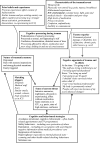Cognitive therapy for post-traumatic stress disorder following critical illness and intensive care unit admission
- PMID: 34191936
- PMCID: PMC7251252
- DOI: 10.1017/S1754470X2000015X
Cognitive therapy for post-traumatic stress disorder following critical illness and intensive care unit admission
Abstract
Around a quarter of patients treated in intensive care units (ICUs) will develop symptoms of post-traumatic stress disorder (PTSD). Given the dramatic increase in ICU admissions during the COVID-19 pandemic, clinicians are likely to see a rise in post-ICU PTSD cases in the coming months. Post-ICU PTSD can present various challenges to clinicians, and no clinical guidelines have been published for delivering trauma-focused cognitive behavioural therapy with this population. In this article, we describe how to use cognitive therapy for PTSD (CT-PTSD), a first line treatment for PTSD recommended by the National Institute for Health and Care Excellence. Using clinical case examples, we outline the key techniques involved in CT-PTSD, and describe their application to treating patients with PTSD following ICU.
Key learning aims: To recognise PTSD following admissions to intensive care units (ICUs).To understand how the ICU experience can lead to PTSD development.To understand how Ehlers and Clark's (2000) cognitive model of PTSD can be applied to post-ICU PTSD.To be able to apply cognitive therapy for PTSD to patients with post-ICU PTSD.
Keywords: COVID-19; ICU; PTSD; critical care; hallucinations; trauma.
© British Association for Behavioural and Cognitive Psychotherapies 2020.
Conflict of interest statement
None.
Figures
Similar articles
-
Cognitive therapy for moral injury in post-traumatic stress disorder.Cogn Behav Therap. 2021 Jan 13;14:e8. doi: 10.1017/S1754470X21000040. eCollection 2021. Cogn Behav Therap. 2021. PMID: 34191944 Free PMC article. Review.
-
Implementing an intensive care unit (ICU) diary program at a large academic medical center: Results from a randomized control trial evaluating psychological morbidity associated with critical illness.Gen Hosp Psychiatry. 2020 Sep-Oct;66:96-102. doi: 10.1016/j.genhosppsych.2020.06.017. Epub 2020 Jul 2. Gen Hosp Psychiatry. 2020. PMID: 32763640 Free PMC article. Clinical Trial.
-
Anxiety, Depression and Post Traumatic Stress Disorder after critical illness: a UK-wide prospective cohort study.Crit Care. 2018 Nov 23;22(1):310. doi: 10.1186/s13054-018-2223-6. Crit Care. 2018. PMID: 30466485 Free PMC article.
-
Moving forward with the loss of a loved one: treating PTSD following traumatic bereavement with cognitive therapy.Cogn Behav Therap. 2023 Apr 20;16:e12. doi: 10.1017/S1754470X23000041. eCollection 2023. Cogn Behav Therap. 2023. PMID: 37159811 Free PMC article.
-
Intensive Care Unit (ICU)-Related Post-traumatic Stress Disorder: A Literature Review.Cureus. 2024 Mar 27;16(3):e57049. doi: 10.7759/cureus.57049. eCollection 2024 Mar. Cureus. 2024. PMID: 38681363 Free PMC article. Review.
Cited by
-
SARCOPENIA IS A FREQUENT DISEASE IN SARS-COV-2 INFECTION.J Rehabil Med Clin Commun. 2023 Jan 31;6:2222. doi: 10.2340/jrmcc.v6.2222. eCollection 2023. J Rehabil Med Clin Commun. 2023. PMID: 36760715 Free PMC article.
-
Study protocol for a randomized controlled trial evaluating the effectiveness of an internet-based self-help intervention to cope with psychological distress due to COVID-19 in the Italian general population: the RinasciMENTE project.Trials. 2022 Sep 24;23(1):801. doi: 10.1186/s13063-022-06714-x. Trials. 2022. PMID: 36153586 Free PMC article.
-
Enhancing your delivery of cognitive therapy for PTSD: a celebration of the work of Hannah Murray.Cogn Behav Therap. 2024 Nov 29;17:s1754470x24000370. doi: 10.1017/S1754470X24000370. eCollection 2024. Cogn Behav Therap. 2024. PMID: 39691804 Free PMC article. No abstract available.
-
Clinical Education: Addressing Prior Trauma and Its Impacts in Medical Settings.J Clin Psychol Med Settings. 2024 Sep;31(3):501-512. doi: 10.1007/s10880-024-10029-1. Epub 2024 Aug 2. J Clin Psychol Med Settings. 2024. PMID: 39095585 Review.
-
Barriers and opportunities for implementation of a brief psychological intervention for post-ICU mental distress in the primary care setting - results from a qualitative sub-study of the PICTURE trial.BMC Prim Care. 2023 May 6;24(1):113. doi: 10.1186/s12875-023-02046-0. BMC Prim Care. 2023. PMID: 37149603 Free PMC article. Clinical Trial.
References
Further reading
-
- Ehlers, A., & Clark, D. M. (2000). A cognitive model of posttraumatic stress disorder. Behaviour Research and Therapy, 38, 319–345. - PubMed
-
- Wade, D., Hardy, R., Howell, D., & Mythen, M. (2013). Identifying clinical and acute psychological risk factors for PTSD after critical care: a systematic review. Minerva Anestesiologica, 79, 944–963. - PubMed
References
-
- American Psychiatric Association (2013). Diagnostic and Statistical Manual of Mental Disorders (5th edn). Washington, DC, USA: American Psychiatric Association.
-
- Colville, G., Kerry, S., & Pierce, C. (2008). Children’s factual and delusional memories of intensive care. American Journal of Respiratory and Critical Care Medicine, 177, 976–982. - PubMed
-
- Deja, M., Denke, C., Weber-Carstens, S., Schröder, J., Pille, C. E., Hokema, F., … & Kaisers, U. (2006). Social support during intensive care unit stay might improve mental impairment and consequently health-related quality of life in survivors of severe acute respiratory distress syndrome. Critical Care, 10, R147. - PMC - PubMed
Publication types
Grants and funding
LinkOut - more resources
Full Text Sources

